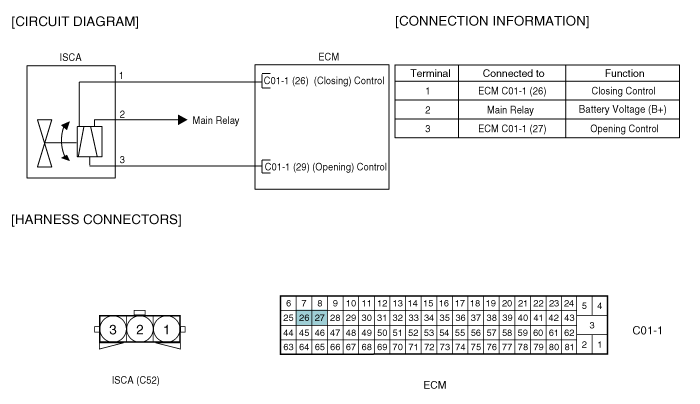Monitor the "ISCA" parameters on the scantool.
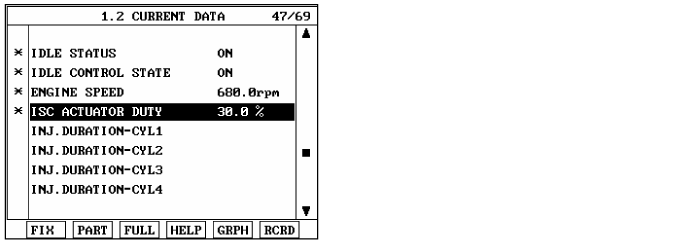

The ISCA (Idle Speed Control Actuator) is designed to maintain a steady desired idle speed. Idle airflow is adjustedthrough the idle air actuator in order to maintain the desired idle speed under various load conditions. Load conditions vary due to numerous factors, such as engine temperature, air conditioning, electrical load and power steering load.
If the real engine speed is higher than the desired engine speed over 200 rpm under enable conditions, PCM sets P0507.
Item | Detecting Condition | Possible Cause | |
DTC Strategy | ● Rationality check, high | ● Poor connection ● Leak in intake air system ● Carbon pile ● ISCA ● ECM | |
General Enable Conditions | ● Vehicle speed = 0 ● Coolant temperature 〉 70℃ ● Intake air temperature 〉 -7.5℃ ● Altitude 〈 3000m ● Idle status | ||
Case 1 | Enable Conditions | ● Idle controller I part = -15% | |
Threshold Value | ● Desired engine speed - Engine speed 〈 -200rpm | ||
Case 2 | Threshold Value | ● Fuel cut-off ≥ 3times | |
Diagnostic Time | ● 15 sec | ||
MIL | ● ON | ||
Connect scantool to Data Link Connector(DLC).
Warm up the engine to normal operating temperature.
Monitor the "ISCA" parameters on the scantool.

Are the parameters displayed correctly?

▶ Fault is intermittent caused by poor contact in the sensor’s and/or ECM’s connector or wasrepaired and ECM memory was not cleared. Thoroughly check connectors for looseness, poorconnection, bending, corrosion, contamination, deterioration, or damage. Repair or replace as necessary and go to "Verification of vehicle Repair" procedure.

▶ Go to "Terminal and connector inspection" procedure.
Many malfunctions in the electrical system are caused by poor harness and terminals. Faults can also be caused by interference from other electrical systems, and mechanical or chemical damage.
Thoroughly check connectors for looseness, poor connection, bending, corrosion, contamination, deterioration, or damage.
Has a problem been found?

▶ Repair as necessary and go to "Verification of vehicle Repair" procedure.

▶ Go to "Power circuit inspection" procedure.
Key "OFF".
Disconnect ISCA connector.
Key "ON".
Measure the voltage between terminal 2 of ISCA harness connector and chassis ground.
Specification : B+
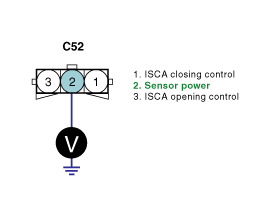
Is the measured voltage within specification?

▶ Go to "Control circuit inspection" procedure.

▶ Repair Open or Short in power circuit and then, go to "Verification of Vehicle Repair" procedure.
Key "OFF".
Disconnect ISCA connector and Key "ON".
Measure the voltage between terminal 1 of ISCA harness connector and chassis ground.
Measure the voltage between terminal 3 of ISCA harness connector and chassis ground.
Specification : Approx 1.7V (at terminal 1), Approx 2V (at terminal 3)
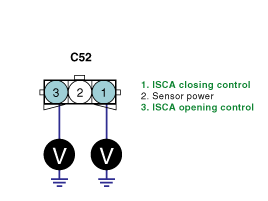
Is the measured voltage within specification?

▶ Go to "System inspection" procedure.

▶ Repair Open or Short in control circuit and then, go to "Verification of Vehicle Repair" procedure.
Visual inspection.
Key "OFF".
Check intake air system
▶ Check assembling state and damage on throttle body gasket.
▶ Check assembling/sealing state and damage on MAFS and PCV valve.
Is everything O.K?

▶ Go to "Component inspection" procedure.

▶ Repair as necessary and then, go to "Verification of Vehicle Repair" procedure.
ISCA visual check.
Key "OFF".
Disassemble ISCA.
Check contamination, damage or stuck on ISCA.
Check the operating sound when key turns "OFF" to "ON".
Is ISCA O.K?

▶ Go to "ISCA check" procedure.

▶ Substitute with a known - good ISCA and check for proper operation.
▶ If the problem is corrected, replace ISCA and go to "Verification of Vehicle Repair" procedure.
ISCA check.
Key "OFF".
Disassemble ISCA.
Measure the resistance between terminal 1 and 2 of ISCA harness connector. (Component side)
Measure the resistance between terminal 2 and 3 of ISCA harness connector. (Component side)
Temperature (℃) | Closing Coil Resistance (Ω) | Opening Coil Resistance (Ω) |
20~35℃ (68~95℉) | 15.4±0.8 | 11.9±0.8 |
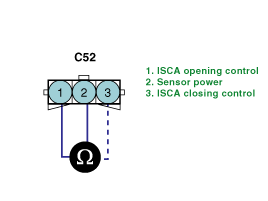
Is the measured resistance within specifications?

▶ Substitute with a known - good ECM and check for proper operation.
▶ If the problem is corrected, replace ECM and go to "Verification of Vehicle Repair" procedure.

▶ Substitute with a known - good ISCA and check for proper operation.
▶ If the problem is corrected, replace ISCA and go to "Verification of Vehicle Repair" procedure.
After a repair, it is essential to verify that the fault has been corrected.
Connect scan tool and select "Diagnostic Trouble Codes(DTCs)" mode.
Clear the DTCs and Operate the vehicle within DTC Enable conditions in General information.
Are any DTCs present ?

▶ Go to the applicable troubleshooting procedure.

▶ System is performing to specification at this time.
